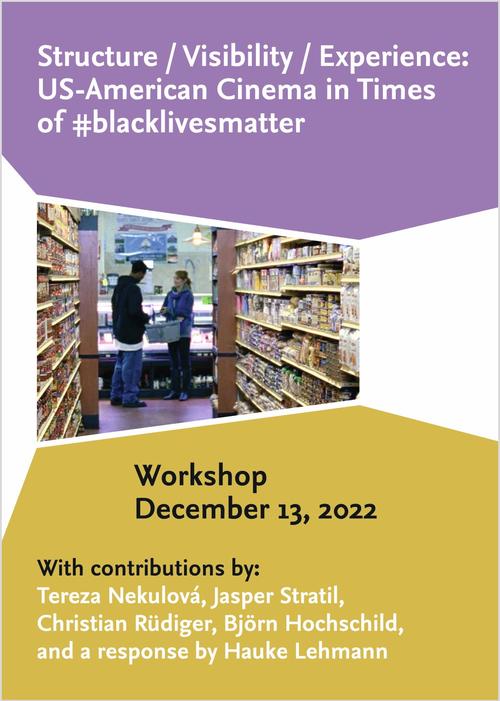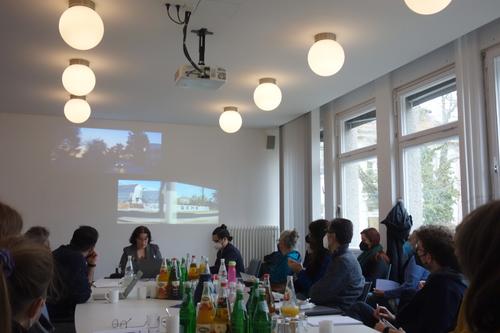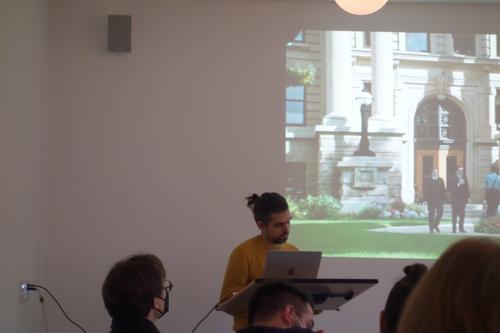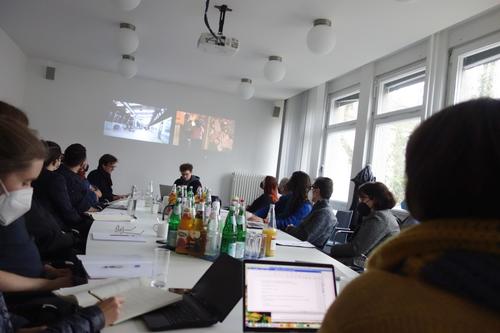Structure / Visibility / Experience: US-American Cinema in Times of #blacklivesmatter
13.12.2022 | Workshop by the Cinepoetics group with Tereza Nekulová, Jasper Stratil, Christian Rüdiger, Björn Hochschild, and Hauke Lehmann.
Research Focus: Digital Cultures II: Phenomenology of the Anthropocene
The workshop was commenced with a statement by Björn Hochschild and Christian Rüdiger who reflected on their work engaging with cinematic depictions of racism and police brutality. What began as project concerned with policing on film more broadly, had to quickly develop to include and forefront the topic of race based both on the filmic material referenced as well as the continued activism of #blacklivesmatter. Applying a phenomenological lens, each contribution to the workshop aimed to explore how a given film negotiates the notion of the structurality of racism as well as the need of and the problems inherent to visibility.
In their joint presentation "Spaces Framing Structures: Predestined Coincidences in Fruitvale Station," Björn Hochschild and Christian Rüdiger developed on this introduction by asking how a social structure might be made visible, when indeed one major mechanism implicit in it, is its obfuscation and normalization. A central aesthetic principle Rüdiger and Hochschild discovered within Fruitvale Station in this context – the pull towards the depth and center of the image created by vanishing lines – dominates most of the film’s scenes. The note of suspense animated in this way impresses on the viewer a sense of predestination exerted on the protagonist’s journey – a structural force that points ultimately to his death. Throughout, Hochschild and Rüdiger related their analytical findings to the perspectives of Afro Pessimism and Black Optimism in order to think race through this process of cinematic orientation.
Tereza Nekulová's talk, "Looking and Looking Back: Melancholic Viewership in Queen & Slim," brought various theory fragments in conversation with images and sequences from the film in order to animate reflection on Black viewership practices, melancholy, and loss.
Nekulová emphasized the role, which different movement qualities and temporal modes play within the film in order to animate its particular melancholic mode. Dissonant affective qualities, movement qualities that disperse across the surface of images or burrow into them all cooperate to give the impression that futurity is always already foreclosed within the film, its protagonists being unable to flee their circumstances and make a life for themselves elsewhere. Importantly, to Nekulová the film does not ultimately impart hopelessness, but aims to develop a resilience in grief. In this way, the film becomes the mediatization of a black viewership practice that does not avert its gaze from a racist visual culture, but subverts and critiques it in looking.
In his presentation, "Critical Horizons. Situating Detroit in Perspective of #blacklivesmatter," Jasper Stratil began by reflecting on the film’s dramatization of the 1967 Detroit Riots as imparting a sense of discomfort with being part of a world that legitimizes injustices.
As the film shifts from a documentary perspective to an ostentatiously fictional one, what is most relevant to Stratil is the construction of a cinematic mode of "being-there-ness" imparted to viewers, rather than the film’s functioning as a faithful reenactment of a real-life event. This mode of experience is enriched through the inclusion of archival footage and an oscillation between different genre modes emphasizing shifts between perspectives and imparting a sense of authenticity. It is in this way that these images may also function as a mode of experience wherein trauma spans an entire community, fading the lines between the private and the public. Stratil concluded that the shared memory of pain expressed here as an embodied viewer-experience attempts to but does not wholly succeed at rendering the structurality of racism visible – the fictionalized police brutality remains understood by the film as an individualized phenomenon.
In his response to each presentation, Hauke Lehmann reflected on the interaction between the question of visibility and that of representation. Starting with a comment on the first presentation, he pointed out that the mentioned vanishing points start and end with the death of the protagonist, underlining the predestination. He suggested that Fruitvale Station might utilize a paranoid rather than suspenseful mode, as the vanishing lines give the impression of something already certain arriving, allowing the present no room to evolve.
Moving on with the second presentation, Lehmann highlighted the notion that in the road movie the car itself becomes a substitute for the camera, everything transforming into images. Lehmann also mentioned the absence of Black protagonists in Hollywood road movies, while also reflecting on the idea that identity might be something spanning the whole of the image rather than being confined conceptually to an actor’s body and presence on screen.
Commenting on the third presentation, Lehmann also drew a connection to the paranoia cinema of the 1970s. Within the film’s merging of journalistic images and art, reenactment seems to drain the present, leaving no space for future change.



